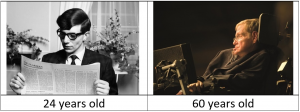
|
Box 1.
|
New Research Supported by Neurodegenerative Disease Research (NDR), Inc
The Naviaux Lab has started a new 2-year collaborative study with expert ALS centers around North America. In this study, we will test how 4 blood samples drawn over 1-2 months can be used to identify the metabolic features of the disease. We will be applying new methods of metabolomics and exposomics analysis developed in our lab to examine over 600 natural metabolites and over 1200 environmental chemicals. The aim is to find clues to the underlying chemistry of inflammation and neurological changes that might lead to new approaches to both general and personalized treatment. Follow-up studies will look at patients who have slowly-progressing and rapidly-progressing forms of ALS to see if metabolomics can discriminate the two.
Background
The incidence of ALS has increased by 14% per decade over the past 25 years in several places around the world1-3. The annual incidence is currently 2-4 per 100,000 in European populations. The lifetime risk of developing ALS is 1:350 for males and 1:420 for females5. Familial forms of ALS (fALS) account for about 5%-10% of all cases and sporadic forms (sALS) account for 90%-95%. The relative contribution of the top 5 genes is different in European and Asian populations6. Dozens of more-weakly interacting genes7, and a number of occupational and environmental risk factors have been identified8. Some of the strongest occupational exposures include heavy metals like lead, mercury, and hexavalent-selenium in drinking water, and solvents like paint thinners that include chemicals like acetone, naphtha, toluene, methyl ethyl ketone (MEK), dimethylformamide (DMF), 2-butoxyethanol and other glycol ethers, and xylenes. Occupational and agricultural exposures to fungicides, fungi, and possibly certain mycotoxins and cyanobacterial biotoxins were also found to increase the risk of developing ALS. Overall, these exposures increase the age- and sex-adjusted odds ratio (OR) of developing ALS from 1.8 to 4.2-fold8.
The median survival for the average patient with ALS with the current best therapies available is 2.5 years. About 5%-10% of patients have more slowly progressing forms and survive more that 8 years3. No therapy has yet been found to be curative or arrest the disease. This is in part because the pathophysiology of ALS is not yet fully understood. A total of 493 interventional trials are currently registered at clinicaltrials.gov. Seventy-five interventional trials are actively recruiting patients as of August 2020. The combination of genes involved in mitochondrial and cellular stress responses9, infectious triggers10, and environmental factors that can trigger the cell danger response11 are strong clues for involvement of the CDR12 in the pathophysiology of ALS. New studies of metabolomics and exposomics of ALS will help solidify this evidence and help to characterize the possible connection to ancient signaling pathways that regulate the pathological persistence of the CDR13 responsible for progressive neuronal loss. These pathways include, but are not limited to, purinergic signaling14-16.
ALS Study Documents Available for Download
References
1. Leighton, D.J., et al. Changing epidemiology of motor neurone disease in Scotland. Journal of neurology 266, 817-825 (2019).
2. Georgoulopoulou, E., et al. Changing incidence and subtypes of ALS in Modena, Italy: A 10-years prospective study. Amyotroph Lateral Scler 12, 451-457 (2011).
3. Hardiman, O., et al. The changing picture of amyotrophic lateral sclerosis: lessons from European registers. J Neurol Neurosurg Psychiatry 88, 557-563 (2017).
4. Brooks, B.R., Miller, R.G., Swash, M., Munsat, T.L. & World Federation of Neurology Research Group on Motor Neuron, D. El Escorial revisited: revised criteria for the diagnosis of amyotrophic lateral sclerosis. Amyotroph Lateral Scler Other Motor Neuron Disord 1, 293-299 (2000).
5. Alonso, A., Logroscino, G., Jick, S.S. & Hernan, M.A. Incidence and lifetime risk of motor neuron disease in the United Kingdom: a population-based study. Eur J Neurol 16, 745-751 (2009).
6. Zou, Z.Y., et al. Genetic epidemiology of amyotrophic lateral sclerosis: a systematic review and meta-analysis. J Neurol Neurosurg Psychiatry 88, 540-549 (2017).
7. Riancho, J., et al. The increasing importance of environmental conditions in amyotrophic lateral sclerosis. Int J Biometeorol 62, 1361-1374 (2018).
8. Filippini, T., et al. Environmental and Occupational Risk Factors of Amyotrophic Lateral Sclerosis: A Population-Based Case-Control Study. Int J Environ Res Public Health 17(2020).
9. Masrori, P. & Van Damme, P. Amyotrophic lateral sclerosis: a clinical review. Eur J Neurol (2020).
10. Celeste, D.B. & Miller, M.S. Reviewing the evidence for viruses as environmental risk factors for ALS: A new perspective. Cytokine 108, 173-178 (2018).
11. Naviaux, R.K. Perspective: Cell danger response Biology-The new science that connects environmental health with mitochondria and the rising tide of chronic illness. Mitochondrion 51, 40-45 (2020).
12. Naviaux, R.K. Metabolic features of the cell danger response. Mitochondrion 16, 7-17 (2014).
13. Naviaux, R.K. Metabolic features and regulation of the healing cycle-A new model for chronic disease pathogenesis and treatment. Mitochondrion 46, 278-297 (2019).
14. Burnstock, G. Purinergic Signalling and Neurological Diseases: An Update. CNS & neurological disorders drug targets 16, 257-265 (2017).
15. Liu, J., et al. Down-regulation of purinergic P2X7 receptor expression and intracellular calcium dysregulation in peripheral blood mononuclear cells of patients with amyotrophic lateral sclerosis. Neurosci Lett 630, 77-83 (2016).
16. Bartlett, R., Sluyter, V., Watson, D., Sluyter, R. & Yerbury, J.J. P2X7 antagonism using Brilliant Blue G reduces body weight loss and prolongs survival in female SOD1(G93A) amyotrophic lateral sclerosis mice. PeerJ 5, e3064 (2017).

